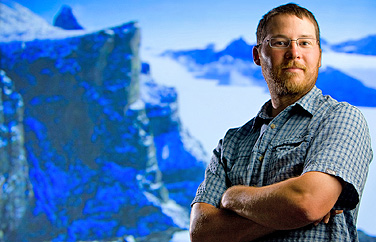News
Ice sheets can retreat in ‘geologic instant’

Jason Briner’s research reveals that modern glaciers in deep ocean water can shrink even more quickly than has recently been observed. Photo: DOUGLAS LEVERE
-
 Print
Print -
 Comments
Comments
-
“If modern glaciers do this for several decades, this would rapidly raise global sea level, intercepting coastal populations and requiring vast re-engineering of levees and other mitigation systems.”
Modern glaciers, such as those making up the Greenland and Antarctic ice sheets, are capable of undergoing periods of rapid shrinkage or retreat, according to new findings by UB paleoclimatologists.
The paper, published on June 21 in Nature Geoscience, describes fieldwork demonstrating that a prehistoric glacier in the Canadian Arctic rapidly retreated in just a few hundred years.
The proof of such rapid retreat of ice sheets provides one of the few explicit confirmations that this phenomenon occurs.
Should the same conditions recur today, which the UB scientists say is very possible, they would result in sharply rising global sea levels that would threaten coastal populations.
“A lot of glaciers in Antarctica and Greenland are characteristic of the one we studied in the Canadian Arctic,” said Jason Briner, assistant professor of geology, College of Arts and Sciences, and lead author on the paper. “Based on our findings, they, too, could retreat in a geologic instant.”
The new findings will allow scientists to more accurately predict how global warming will affect ice sheets and the potential for rising sea levels in the future by developing more robust climate and ice sheet models.
Briner said the findings are especially relevant to the Jakobshavn Isbrae, Greenland's largest and fastest moving tidewater glacier, which is retreating under conditions similar to those he studied in the Canadian Arctic.
Acting like glacial conveyor belts, tidewater glaciers are the primary mechanism for draining ice sheet interiors by delivering icebergs to the ocean.
“These ‘iceberg factories’ exhibit rapid fluctuations in speed and position, but predicting how quickly they will retreat as a result of global warming is very challenging,” said Briner.
That uncertainty prompted the UB team to study the rates of retreat of a prehistoric tidewater glacier of similar size and geometry to contemporary ones as a way to get a longer-term view of how fast these glaciers can literally disappear.
The researchers used a special dating tool at UB to study rock samples they extracted from a large fjord that drained the ice sheet that covered the North American Arctic during the past Ice Age.
The samples provided the researchers with climate data over a period from 20,000 years ago to about 5,000 years ago, a period when significant warming occurred.
“Even though the ice sheet retreat was ongoing throughout that whole period, the lion’s share of the retreat occurred in a geologic instant—probably within as little as a few hundred years,” said Briner.
The research reveals that the period of rapid retreat was triggered once the glacier entered deep ocean waters—nearly a kilometer deep, Briner said.
“The deeper water makes the glacier more buoyant,” he explained.
“Because the rates of retreat were so much higher in the deep fjord, versus earlier when it terminated in more shallow waters or on land, the findings suggest that contemporary tidewater glaciers in Greenland and Antarctica that are retreating into deep waters may begin to experience even faster rates of retreat than are currently being observed,” said Briner.
Right now, Jakobshavn Isbrae is draining into waters that are nearly a kilometer deep, he said, which means that its current rates of retreat—as fast as 10 kilometers in the past decade—could continue for the next hundred years.
“If modern glaciers do this for several decades, this would rapidly raise global sea level, intercepting coastal populations and requiring vast re-engineering of levees and other mitigation systems,” said Briner.
Co-authors on the paper are Aaron C. Bini, formerly a master’s of science candidate in the UB Department of Geology, and Robert S. Anderson of the Department of Geological Sciences at the University of Colorado-Boulder.
The research was funded by the National Science Foundation.

Reader Comments